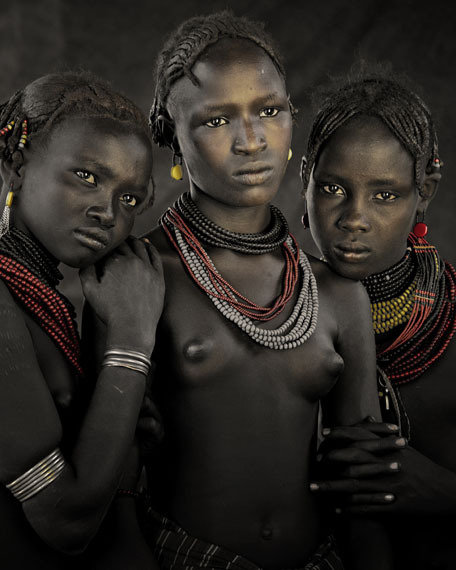Jimmy Nelson
dal 7/3/2014 al 20/6/2014
Segnalato da
7/3/2014
Jimmy Nelson
Camera Work Contemporary Gallery, Berlin
Before They Pass Away. The exhibition and its over 80 works is shown to give an insight into the epochal series. They will be shown simultaneously in the galleries Camera Work and CWC Gallery.

CAMERA WORK and CWC GALLERY are pleased to present the internationally awaited exhibition "Before They Pass Away" by Jimmy Nelson, starting on March 8, 2014. For the first time worldwide, the exhibition and its over 80 works is shown to give an insight into the epochal series "Before They Pass Away". As an appraisal of the artist and due to the enormous quantity of photographs within this collection the series will be shown simultaneously in the galleries CAMERA WORK and CWC GALLERY – being an honor that has never been awarded to any artist by CAMERA WORK before.
In many respects, the term "unique" describes the people portrayed by Jimmy Nelson best: So inimitably fascinating are the Huli Wigmen – painted in red, yellow and white - in Papua New Guinea, so exotic are the Karo in Ethiopia and so affecting are the Himba tribe in Namibia. Representatives of the world’s last indigenous peoples are the protagonists in Nelson’s photographs. His works go far beyond serving solely as a neutral visual document, serving the public’s vague idea about the existence of those tribesmen and peoples. With his epochal series, Jimmy Nelson establishes an awareness for the fascinating variety of the culture- and historycharged symbols of the people, reflecting their rites, customs and traditions, that hitherto has not existed to this extend. Among several other countries his journeys led Nelson to Ethiopia, Tanzania and Kenya, to China and Nepal or Siberia and Mongolia. The cultural prosperity of the indigenous populations of those countries differentiates itself even further within each single tribe in a new and different way.
The spectator is confronted with the unknown and foreign in a genuine sense through the unfamiliar exoticism of the luxuriant fur robes of the Kazakhs in Mongolia, the colorful cloths of the Maasai in Tanzania, the pearl jewelry and feather decorations of the inhabitants of Goroka in Papua New Guinea, or the unembarrassed bare skin, if not tattooed or painted, of the Karo in Ethiopia. The decoration in its diversity evokes an almost mystic atmosphere. The positive irritation about the manifoldness of cultural expressions is inherent with the appeal to protect and beware the people that generate it. Yet besides the disconcertment, it is the effort for beauty, noticeable in all of those cultural artifacts, that functions as a linking element and is furthermore reflected in the way of the photographs’ composition and aesthetics, thus integrating the spectator through the aesthetic sentiment.
Jimmy Nelson is not a scientist. Rather than trying to find answers, he wants to tell stories that leave room for the recipient’s questions. He succeeds in doing so due to his unique stylistic approach regarding this ethnologic level. The 80 – partly large-sized – photographs shown in the exhibition withdraw from distinct categorization: They oscillate between being a visual testament of authenticity and being the expression of a calculus of composition committed to the ideas of beauty, pride and dignity. Pride and dignity lie in the looks of the portrayed persons’ eyes that are vigorous enough to transcend the photograph’s restriction by frame even in front of a totally diminished background. They tell exactly those stories that are of vital importance to Jimmy Nelson and that he is keen to find on his journeys. The Dassanech girl’s direct gaze into the camera reflects an almost challenging selfCAMERA confidence, which seems to be fed on the certitude of their social cohesion, also suggested by the intimate gestures between the three girls. The two other girls’ eyes, gazing off into the distance, show a certain melancholy and grace, going beyond the moment they were photographed. Not only gentleness but also strength come along with the expression of the Maori girl wearing a rope richly embroidered with feathers.
The photographs almost seduce their spectators as they establish a world full of unknown but meaningful symbols whose reference seems to elude classification. At the same time iconographies out of the collective fund of the globalized world can be identified for example in the way the tribesmen are positioned in the surrounding epic landscapes. They oversee their territory from mountaintops and hills creating the impression of a harmonic connection with nature on the one hand but simultaneously revealing a possessive approach towards it on the other hand. Bow and arrow, as carried by the two men on the Vanuatu islands, or the positioning of the three Samburu men photographed from behind with spears in their hands and stuck in the ground, emphasize this attitude furthermore. Different perspectives and layers of meaning thus seem to overlap and intermingle in the photographs. Their contents’ authenticity poses the question as to which extent, or in which cultural frame, such attributes can be attested by the spectator. For the tribesmen their bodies are jewelry just as the ones they decorate them with. This game with signs, repeated by Nelson in his visual language, encodes his works with ambiguity, is eventually a game of appearances. To generally bring appearances into question is one of the central messages Nelson took with him on his journeys.
Image: ODITA, ARBOSHASH & NIRJUDA, DASSANECH TRIBE OMORATE VILLAGE, SOUTHERN OMO VALLEY, ETHIOPIA, 2011
CWC GALLERY Camera Work Contemporary
Auguststr. 11, 10117 Berlin
Tue-Sat 11am-7pm
CAMERA WORK
Kantstr. 149, 10623 Berlin
Tue-Sat 11am-6pm



